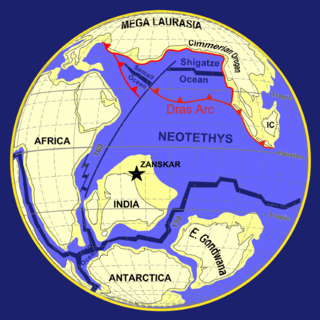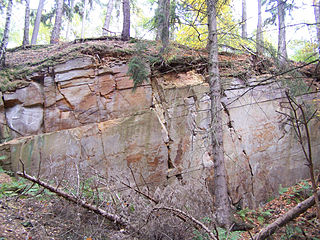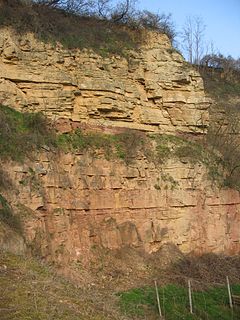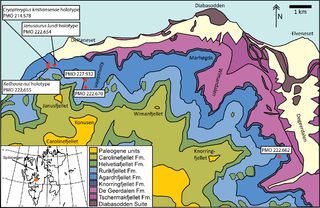 W
WThe Central Pangean Mountains were an extensive northeast-southwest trending mountain range in the central portion of the supercontinent Pangaea during the Triassic period. They were formed as a result of collision between the minor supercontinents Laurussia and Gondwana during the formation of Pangaea. Remnants of this massive mountain range include the Appalachian Mountains of North America, the Little Atlas of Morocco, Africa and much of the Scottish Highlands including Ben Nevis.
 W
WThe Cimmerian Orogeny was an orogeny that created mountain ranges that now lie in Central Asia. The orogeny is believed to have begun 200–150 million years ago, when the Cimmerian plate collided with the southern coast of Kazakhstania and North and South China, closing the ancient Paleo-Tethys Ocean between them. The plate consisted of what are now known as Turkey, Iran, Tibet and western Southeast Asia. Much of the plate's northern boundary formed mountain ranges that were as high as the present-day Himalayas. The orogeny continued well into the Cretaceous and Early Cenozoic.
 W
WThe Dinwoody Formation is a geologic formation in Montana. It preserves fossils dating back to the Triassic period.
 W
WThe Exter Formation is the only formation of the Upper Keuper or Rhätsandstein, and is a geologic formation in Germany. It preserves fossils dating back to the Rhaetian of the Triassic period.
 W
WGow is an impact crater in Saskatchewan, Canada.
 W
WThe Grès à Voltzia is a geologic formation in France. It preserves fossils dating back to the Triassic period.
 W
WThe Han-Bulog Formation is a geologic formation in Albania. It preserves fossils dating back to the Olenekian to Anisian of the Triassic period.
 W
WThe Kapp Toscana Group is a geologic group in Svalbard and Jan Mayen in the Barents Sea, Norway.
 W
WThe Lilstock Formation is a geologic formation in England. It preserves bivalve, insect and other invertebrate fossils, as well as fossil fish of Agkistracanthus mitgelensis and the basal theropod dinosaur "Zanclodon" cambrensis dating back to the Rhaetian of the Triassic period.
 W
WThe Sanga do Cabral Formation is a sedimentary rock formation found in Rio Grande do Sul, Brazil.
 W
WThe Sassendalen Group is a geologic group in Svalbard, Norway. The marine to deltaic mudstones, siltstones and sandstones preserve fossils dating back to the Early Triassic period.
 W
WThe Scunthorpe Mudstone is a geologic formation in England. It preserves plesiosaur fossils dating back to the Late Triassic (Rhaetian) to Early Jurassic (Hettangian) period. It predominantly consists of grey mudstone with thin beds of argillaceous limestone and calcareous siltstone. The Ichthyosaur Wahlisaurus is known from the formation. As is the holotype specimen of the dinosaur Sarcosaurus.
 W
WThe Slide Mountain Ocean was an ancient ocean that existed between the Intermontane Islands and North America beginning around 245 million years ago in the Triassic period. It is named after the Slide Mountain Terrane, which is composed of rocks from the ancient oceanic floor. There was a subduction zone on the Slide Mountain Ocean's floor called the Intermontane Trench where the Intermontane Plate was being subducted under North America. The floor of the Slide Mountain Ocean was pushed up onto the ancient margin of North America.
 W
WSuvasvesi is a lake in Eastern Finland near the town of Kuopio. Suvasvesi consists of two circular open lakes, Kuukkarinselkä in north and Haapaselkä in south. The lakes are separated by a group of islands. The lake has 688 islands in total. The area of the lake is 234 square kilometres (90 sq mi) making it the 18th largest lake in Finland. Kuukkarinselkä is the third deepest lake in Finland measuring 89.0 metres (292.0 ft) in the deepest point.
 W
WThe Trujillo Formation is a geologic formation in Texas and New Mexico. It preserves fossils dating back to the upper Triassic period.
 W
WThe Tschermakfjellet Formation is a geological formation in Svalbard, Norway, a subunit of the Kapp Toscana Group. The formation dates to the Late Triassic.
 W
WThe Twillingodden Formation is a geologic formation in Svalbard, Norway. It preserves fossils dating back to the Smithian period.
 W
WThe Upper Maleri Formation is a sedimentary rock formation found in Telangana, India. It is one of the formations of the Pranhita–Godavari Basin. It is of late Norian and possibly earliest Rhaetian ages, and is notable for its fossils of early dinosaurs.
 W
WThe Vardebukta Formation is a geologic formation in Norway. It preserves fossils dating back to the Early Triassic (Dienerian) period.
 W
WThe Vikinghøgda Formation is a geologic formation in Svalbard, Norway. It preserves fossils dating back to the Early Triassic (Griesbachian-Smithian) period.
 W
WThe Wilhelmøya Formation is a geologic formation in Svalbard, Norway. The marginal marine; concretionary, sideritic sandstones preserve indeterminate ichthyosaur and plesiosaur fossils dating back to the Rhaetian period.